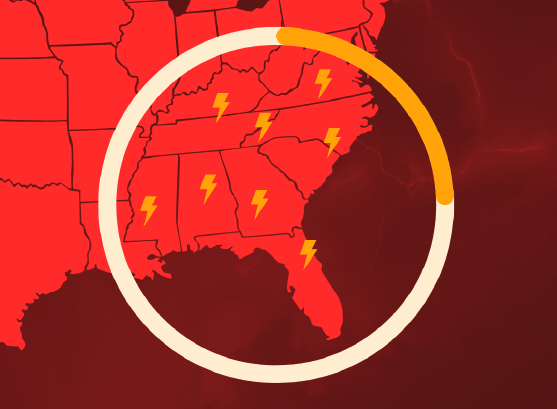Southeast Energy Opportunities Require a Bigger, Better, Faster Grid: Business Leaders Call for Regional Transmission Planning

Brattle Report Highlights Value of Regional Grid Investments — Long-term Regional Planning Offers Billions in Savings and Greater Reliability to Support Growing Southeast Economy
A new study from The Brattle Group, with support from the Southern Renewable Energy Association (SREA), the Carolinas Clean Energy Business Association (CCEBA), and the Clean Energy Buyers Association (CEBA), reveals that the Southeast must modernize its approach to investing in its regional power grid infrastructure to support economic growth, energy affordability, and long-term resilience.
The report highlights that while electricity demand in the Southeast is soaring due to new manufacturing, data centers, and population growth, the region is the only major U.S. market that has not approved a single regional transmission project in recent history. Instead, Southeast transmission planning is limited to identifying upgrades within each individual utility company, forgoing the opportunity to identify more beneficial regional solutions.
As a result, businesses and families are paying higher energy costs while facing greater risks of blackouts that cause significant economic damages that we have seen in extreme weather events like Winter Storms Elliott and Uri. More holistic regional planning can address both issues. Moving forward, Southeast utilities can leverage best practices from across the industry for identifying high-value regional upgrades to support load growth and efficiently add new generation resources across the region.
Key Findings from The Brattle Group Report:
🔹 Power Demand Surge: By 2035, electricity demand in the Southeast is projected to grow by 20 gigawatts (GW), a 25% increase, equivalent to adding twice the power demand of New York City in just 10 years.
🔹 Cost Savings from Regional Transmission: Investing $5 billion in new regional transmission projects would generate over $8 billion in savings for customers, cutting electricity costs and improving grid reliability.
🔹 Grid Reliability at Risk: Extreme weather events — winter storms, hurricanes, and heat waves — are placing greater stress on the grid, yet utilities continue planning transmission in isolation rather than coordinating on cost-effective regional solutions.
🔹 The Southeast Lags Behind Other Regions: The Southeast remains the only major U.S. region that has not approved a regional transmission project, while other markets have strategically invested billions to strengthen their grids and are reaping those savings.
The report follows the Federal Energy Regulatory Commission’s (FERC’s) Order 1920, which created a process to modernize long-term transmission planning. Undertaking meaningful long-term transmission planning presents a major opportunity for the Southeast to shift away from a reactive, near-term, siloed approach to grid investment and adopt best-in-class regional planning that yields higher benefits.
“The business community — Fortune 500 companies, manufacturers, data centers — understands that an outdated power grid is a business risk,” said Katie Southworth, CEBA’s deputy director of market and policy innovation for the Southeast. “The Southeast has the opportunity to unlock billions in cost savings, increase grid resilience, and support clean energy growth. Failing to modernize our transmission planning means businesses will look elsewhere to invest.”
“The Southeast needs to build a grid that matches its growing economy,” said Simon Mahan, executive director of the Southern Renewable Energy Association (SREA). “Manufacturers and data centers are bringing jobs to the region, but without a modern transmission system, we risk higher energy prices, power shortages, and lost economic opportunities. The utilities can’t keep just patching up local lines — regional investment is the only way forward.”
“Businesses want access to reliable, affordable power, but the Southeast transmission planning process needs to improve to make that happen efficiently,” said Chris Carmody, executive director of the Carolinas Clean Energy Business Association (CCEBA). “Other regions are making smart grid investments that lower costs and improve reliability. We should update our process and widen our focus. Now is the time for state regulators and utilities to act so that we can build a more competitive, and resilient, energy future.”
As a leading economic consulting firm that works with utilities, regulators, and policymakers, The Brattle Group does not advocate for specific policy changes. However, the firm’s analysis underscores the economic and reliability benefits of a regional transmission strategy that aligns with industry best practices.
“Our research found that investing in regional transmission upgrades in the Southeast would deliver significant cost savings and reliability improvements,” said Michael Hagerty, principal at The Brattle Group. “While the Southeast planning entity and utilities in the region are evaluating transmission investments, a more coordinated regional and interregional approach would maximize efficiency and reduce electricity costs for customers. Improved regional planning that utilizes a comprehensive set of benefit metrics and studies multiple future scenarios is a critical new tool for the Southeast to embrace for efficiently investing in its future grid.”
The Southeast must move beyond outdated, siloed planning, and nearly all generation resources require transmission. Energy isn’t consumed where it’s generated — it must move freely to where and when it’s needed. Building a bigger grid to capture a generational economic opportunity requires more cost-efficient transmission. Without modern infrastructure, the region risks higher costs, increased blackouts, and lost economic opportunities. Regulators and utilities must step up and take a regional approach to transmission planning to protect consumers and strengthen the economy.
